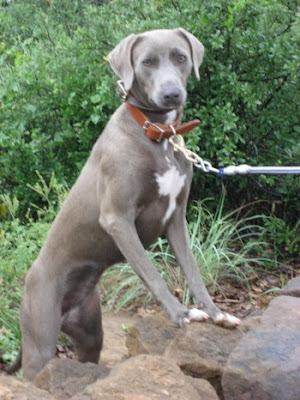Blue Lacys Character are easy to handle, and can be spectacular working dogs. They are energetic and dedicated, capable of handling the meanest Longhorn cattle or most jittery of hens, taking to the job instinctively. They are known to replace the work of a cowboy by five times. This breed is also used for hog hunting, blood trailing, treeing, bird hunting, agility, and search and rescue. They are also suitable as watchdogs. Temperament is stable and outgoing, yet dignified. Shyness in a Lacy is considered a major fault.
Emma is a young Blue Lacy mix, a medium‐sized dog. She is a genuinely happy dog who some basic commands like sit, down, and off. (She does everything better with treats of course!) Emma loves to romp around with other dogs and has been great around kids. She also likes to lounge around the house or outside. She enjoys a good jog and would be a great running partner! She has some separation anxiety and would do great in a home with a yard and other dog(s). It's tough for a pup when you're used to a whole pack of friends! Emma is looking for her fur‐ever home and is hoping you are it!
The origin of the unusual slate blue coat and nose is a genetic rarity. All Lacy dogs have minimal to full white markings on their brisket and most of the time on paws.
* The light gun-metal gray to almost black Lacys are classified in color as Blue
* The red, yellow to cream colored Lacys are classified in color as Red
* The tri-colored Lacys are blue with red points over their eyes, on muzzle, under tail and down the legs. These Lacys are classified as Tri Both the red and tri colored Lacy hold the name Blue Lacy due to the blue color gene they possess.
COAT
Smooth, tight, sleek and exceptionally clean in appearance. It is neither wooly, long or rough in appearance. The tail and hocks should be free of flagging or longer hair. The coat is sleek, glossy and healthy in appearance. Dogs with alopecia will exhibit a dull, rough coat which is sparse and balding, and the skin can be seen readily under the coat. Generally on the tail, ears and across the spine is the most prominent area for alopecia. A non-typical coat is a severe fault.
HEAD
Should be proportionate to the body. The top of the skull is flat to slightly rounded, but not domed. The stop is moderate, but defined. The flews should be tight and not noticeable droopy. The muzzle tapers to a rounded tip. The nose leather should be completely pigmented. a) EYE : All Lacy eyes are a very bright and distinctive orange to yellow color, which adds a unique touch to their appearance. A brownish eye is a fault. The eye set is slightly to an oblique position, is almond shaped, moderately sized, and expresses intelligence. It is neither prominent nor sunken, but well defined and perfectly positioned with dark pupils. A round eye is considered a fault. b) EARS Set is just off the skull at the side of the head, triangular and slightly rounded and 4 to 5 inches in length. Length is measure by bringing the tip of the ear across the eye to the bridge of the muzzle. The ears, at full attention, break slightly forward and lay to the side of the head. Pricked ears, long and/or heavily leathered ears are a severe fault. c) TEETH The teeth should meet in a scissors bite. A level bite is a fault.
NECK AND BODY
The neck is of medium length, is firm, elegant and muscular, clean and arched at the crest; setting well into the shoulders. The body is firm and muscular. The top line appears level at a natural four-square stance. A roach back or sway back must be penalized. The chest is deep and comes to the elbow, with ribs that are well sprung, but are not slab sided or round. The loin is strong and broad when viewed from the top. The bottom line is carried well back with apparent tuck up. The croup moderately slopes to the tail. Tail is straight and can curl upward when the Lacy is on alert. A natural bobtail, crook tail or excessively curled tail is a fault.
GAIT
Smooth, free and easy; exhibiting agility of movement with a well balanced, ground covering stride. Fore and hind legs move straight and parallel with the center line of the body; as speed increases, the feet, both front and rear, converge toward the center line of gravity of the dog, while the top line remains firm and level.
FOREQUARTERS
The shoulders are well laid back, measuring about three fingers apart at the tips of the withers and are well muscled. The legs are vertical when viewed from the front and from the profile. The elbows are close to the ribs and are without looseness. The legs are straight and powerful. Pasterns are straight and strong, but are still flexible. Feet are spoon shaped, compact with close knit and well arched toes. Pads are thick and resilient; nails are strong. Dewclaws may be removed or left natural.
HINDQUARTERS
Thighs are strong and well muscled. Angulation of both stifle and hock joint should achieve the optimal balance of drive and traction. When viewed from the rear, the hocks are parallel to each other and low to the ground.















0 comments:
Post a Comment